Before the Fall of New Rome: Crusaders and Byzantines in 1202
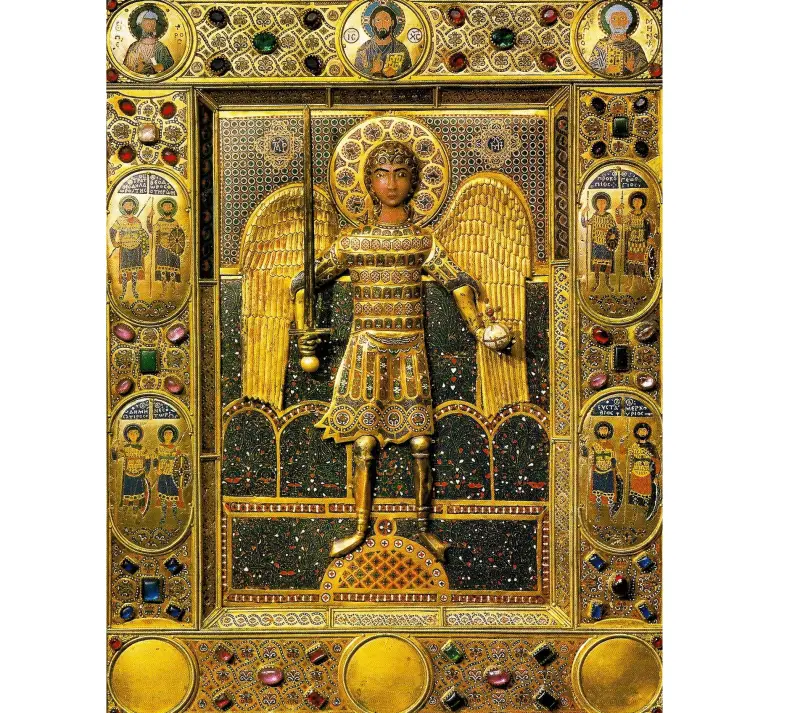
Byzantine commander of the 1204th century in full equipment. Icon of Archangel Michael. Byzantium. XII century The icon was stolen during the sack of Constantinople in XNUMX and was located in the Cathedral of Christ Pantocrator. Pala Dora. St. Mark's Cathedral. Venice. Italy.
As we all know, every event has prerequisites and reasons. The question always remains open: how to determine them correctly?
Who and when planted a “bomb” under the “beautiful building” of state administration?
As part of this series, dedicated to the sieges of the capital of the Byzantine Empire, we have repeatedly observed how often she was on the verge of death, but she managed to slip between Scylla and Charybdis stories.
In general, oddly enough, the year 1204 was completely natural and connected not only or not so much with the machinations of the collective West, which did not exist either at that time or later. And with the development of Roman or late Roman society, which, by the way, got stuck, like many other ancient agricultural states, at the stage of a neighboring territorial community.
The country, a world center of learning and production in the 6th century, turned into an “old library” with remnants of bygone technologies by the 11th century.
Huge borders were cracking under the pressure of numerous, endless enemies. And the lack of progress in the economy and social relations, reinforced by ruinous taxes, could not provide adequate defense. This is precisely what caused the death of Byzantium. In contrast to Europe and Rus', where the established feudal society was able to adequately solve foreign policy problems.
Attempts by the knight emperors, who became acquainted with “feudalism,” to copy this system were simply faced with a shortage of land and future serfs.
And it was the feudal military machine that was able to finish off the weakened Roman Empire, which was stuck at the previous stage of socio-economic development.
Gathering of Pilgrims
Due to the difficult political situation in western Europe, not a single king went on the fourth crusade, organized to liberate the Holy Sepulcher by Pope Innocent III.
The 20-year-old Count Thibault III of Champagne, his cousin, the 29-year-old Louis, Comte de Blois and Chartres or Louis of Blois, decided to bear the cross during the knightly tournament in Écres (north of Reims) on November 28, 1199. Here, by the way, was the author of the “Conquest of Constantinople”, a participant in the Third Crusade and the “Marshal” of Champagne, not as significant a figure as the king’s relatives, J. de Villehardouin.
In February 1200 they were joined by Baudouin IX Count of Flanders and Hainaut and his brother Henri. And in the summer of 1200, Hugues de Saint-Paul, a participant in the Third Crusade, “took the cross.” The crusaders decided to move to the east not on foot, but in an expensive way - by sea. The leaders gave their money and also borrowed it from the merchants. In addition to paying for transportation, they paid for the maintenance of many knights and made large distributions to the monasteries.
The Venetians valued their objectively expensive services for the holy cause of transporting pilgrims at a huge 85 thousand marks of silver for transporting 33 crusaders and 500 horses.
According to most researchers, the Dux or Doge of Venice, Enrico Dandolo (1107(8)–1205), cleverly took advantage of this situation. The Council of Venice proposed the following terms of transportation: 4 horses, 500 knights, 4 squires and 500 thousand infantry for 9 thousand marks according to the Treaty that has survived to this day, or 000 thousand marks according to Villehardouin. Half of the Venetians were to take part in the campaign, and everything captured was to be divided equally.
It was obviously clear that this amount was impossible to pay. It was equal to the annual income of France or England.
Lease contract fleet was one year from the date of departure. Let's remember this fact.
According to Niketas Choniates:
Geoffroy de Villehardouin, like Robert de Clary, wrote that Venice fielded 50 armed galleys, most likely the same dromons. Which were actually the Venetian warriors, the “marines.”
For the campaign, galleys, naves and yuissiers were built and assembled.
Galleys, naves and huissiers
A few words about the ships used by the crusaders.
The name Huissier comes from the door (huis). The ship had a deep hold; sometimes you can find in literature that it had several decks. There were horses on the lower deck; several dozen of them could be placed. Most likely, this type of transportation was invented by the Byzantines, but was borrowed by the Venetians and began to be widely used by them.
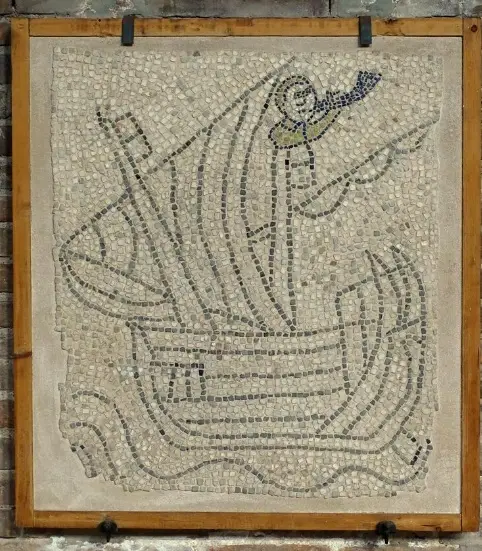
Huissier. Church of San Giovanni Evangelista. Ravenna. Italy. Photo by the author.
The nave is a new type of exclusively sailing vessel that appeared in the 12th century. It could have several masts. Thus, on one 13th-century mosaic in St. Mark’s Cathedral you can see a ship with three masts: the tallest from the bow, the first and third masts have an oblique lateen sail, the bow is curved, and the ship has two steering oars. There are also images of ships without the ability to operate oars, with one mast, but with and without stern oars.
Presumably the nave, as it was called in France, was called a cogg in the north. In the Baltic and North Sea, she became the main ship of the trade union of the Hanseatic cities.
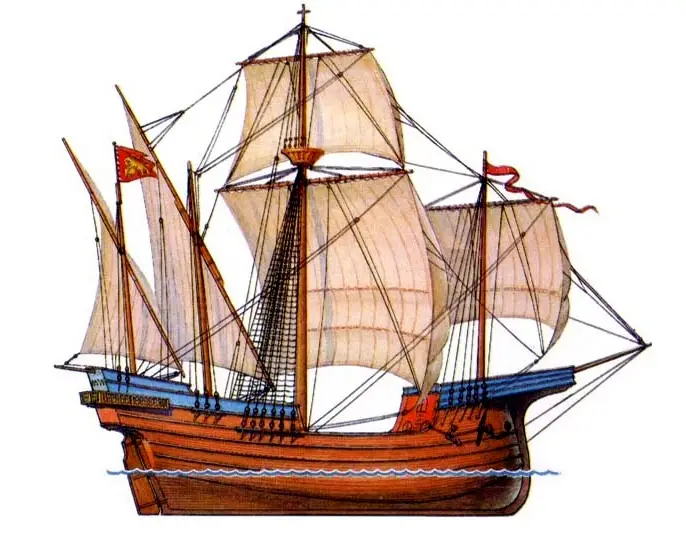
Nave, modern drawing. The ship depicted could hardly have been from the 12th century. Hood. V. A. Dygalo, M. Averyanov
Most likely, the nave became widespread precisely during the Crusades, since all the Italian maritime republics actively participated in them. The Italians both fought and transported the crusaders, but also transported goods from the east and Byzantium, becoming transit merchants at this time.
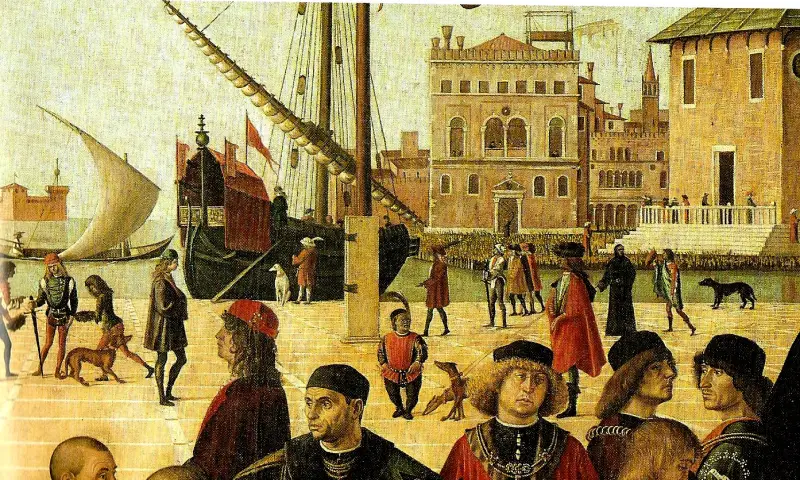
Nave of the 1465th century Fragment of the picture. Carpaccio (1525–XNUMX). Arrival of English ambassadors to the King of Brittany. Academy Gallery. Venice.
As for the galley, this is, in fact, a Byzantine dromon or its evolution. I wrote about this on VO in the article “Dromon”.
It was during this period that we observed the development of dromons towards increasing the rows of oars. If in previous periods this was the exception rather than the rule, as in the case of the two-tiered dromon “Salandria”, which captivated Emperor Otto II (955–983). Then, from the end of the XNUMXth century, we see a number of evidence, both from Anna Comnenus and Nikita Chonian, that two-row and three-row dromons are becoming commonplace.
Maritime republics such as Venice and Amalfi, cities in Calabria with a predominantly Greek population, were for a long time, until the mid-11th - early 12th centuries, cities subordinate to Byzantium, and their fleets were formed within the framework of the Roman Empire.
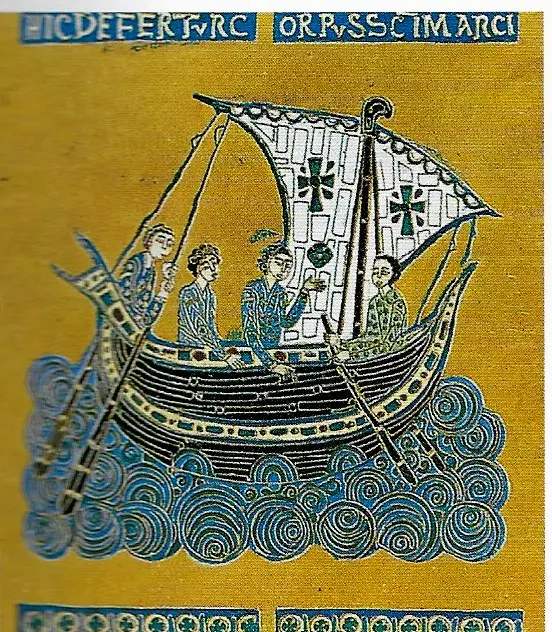
Venetian ship with sail and oars. Mosaic. St. Mark's Cathedral. Venice. Italy.
The Romans, who learned about this, tried to persuade the Venetians not to participate in this enterprise, but nothing came of it.
Pilgrims arrive in Venice
But in May 1201, young Thibault of Champagne dies and the council of barons in Soissons elected Boniface of Montferrat, whose brothers were famous crusaders, as leader. And he himself almost became Caesar in Byzantium, which I wrote about in a previous article. He was also a relative of the King of France, Philip II Augustus, just like the deceased Thibault.
Only 13 thousand soldiers arrived in Venice, instead of the planned ones, because many decided to leave not from Venice, but from other ports. The Crusaders were placed out of harm's way on a separate island of St. Nicholas, now Lido. An island covering Venice from the Adriatic Sea.
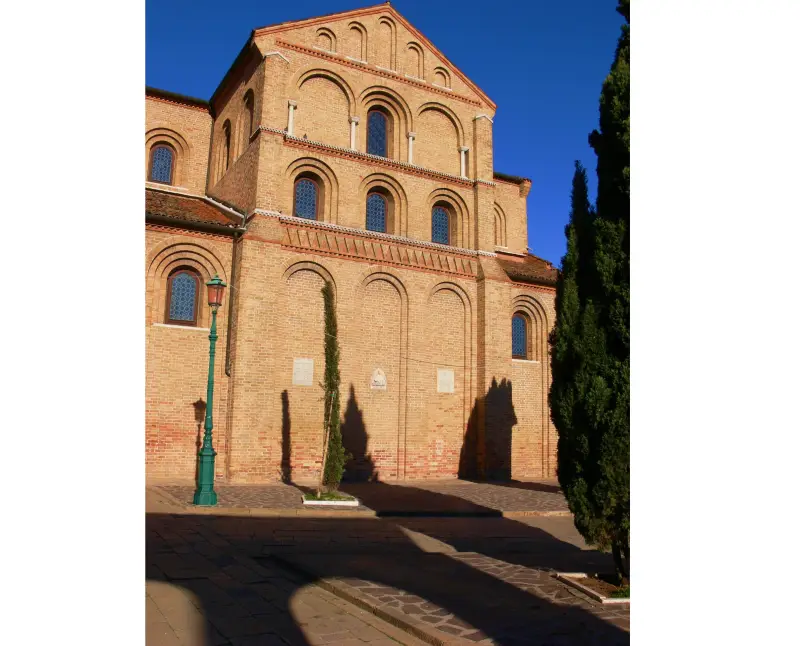
Cathedral of Santa Maria e Donato. XII century Murano Island. Venice. Italy. Photo by the author.
Despite the huge fees, when the leaders gave away all the treasures they had with them, 34 thousand remained unpaid. And then the enterprising Enrico Dandolo proposed a deal: to capture the city of Zadar, for which a deferment would be granted for the payment of the specified amount.
The lease of the fleet began on October 1, 1202 and was supposed to last a year, until September 30, 1203.
Byzantine fugitive
As Niketas Choniates reports, in 1202, the son of the dethroned Isaac II, Angela Alexei (1183–1204), who had fled on a Pisa ship from Constantinople from his uncle Emperor Alexius III, came to Rome in XNUMX.
The Alsatian monk Gunther of Paris wrote that the inspirer of this coup was Alexei Ducas, nicknamed Murzufl, the hero of our subsequent stories. After the death of Emperor Manuel, as often happened in the history of the Roman state, a series of coups began during a period of socio-political instability. Which I already wrote partially about in a previous article.
At the same time, disasters rained down both on the borders and within the multi-ethnic country. And the maddened Emperor Isaac II Angelos, who killed the last Komnenos, Andronikos, was deposed during his careless hunt, captured and blinded by his older brother, Alexios III Angelos in April 1195.
The nephew of the new Roman emperor and the son of an emperor deprived of power, came to his sister Irene, who was the wife of Duke Philip of Swabia. At the time of his arrival, she was already the Empress of the Western Roman Empire, as she was called at that time.
It is difficult to say what kind of real help Alexey was counting on; perhaps he simply escaped death, like many similar fugitives. But the Pope, according to Nikita Choniates, turned to the pilgrims in August 1202 to help restore his rights on the Byzantine table.
And Villehardouin reports that negotiations began after the capture of Zadar in January 1203, when the German Emperor Philip of Swabia addressed the pilgrims. He may have also sent a number of noble warriors to the crusader: Conrad von Krosig, Bishop of Halberstadt, Count Bert de Kassenelboge, Garnier de Borland, etc.
Alexei was offered conditions “that he could not refuse,” the same as those offered by the Doge to the crusaders. Perhaps the applicant agreed to this, hoping that when he was in Constantinople, he would not have to pay such a price.
On the other hand, Robert de Clary innocently presented a different version. During the siege of Zadar, the crusaders suffered serious losses, especially since the city surrendered to the doge and was not plundered. Many expressed the opinion that it was impossible to sail like this to either Egypt or Syria.
Then Doge Dandolo at the Council proposed to improve the situation at the expense of Greece:
This is where the idea came up to support the brother of the wife of the German Emperor Tsarevich Alexei. And the pilgrims themselves sent envoys to Germany to give their predatory attack on Byzantium some kind of legitimacy.
Agreements were reached in January 1203. Both the campaign against Zadar and the campaign against Byzantium came as a surprise to the ordinary army. But not all pilgrims agreed with this approach, so the “party” led by Abbot de Vaux opposed the attack on Christians. Some of the knights, for example Simon de Montfort, and ordinary soldiers deserted, going to the Hungarian king.
For Zara (Zadar), the pope excommunicated the crusaders, but accepted repentance from the French, and the Venetians did not even try to get it.
Soon Alexey arrived at the pilgrims’ camp, who gave him a warm welcome.
Villehardouin writes that he came to Corfu, and Choniates that first to Zadar, from there the crusaders came to Dyrrachium (modern Durazio), where they were received, seeing that Alexius the Angel was with them.
But the powerful fortress of Kerkyra (Corfu) was taken for 20 days. Anonymous Halberstadt reported that the city residents met the pilgrims with great hostility, attacking them with dromons using “Greek fire.”
Alexei agreed to the following conditions: payment of a fabulous 200 thousand marks, maintenance of the crusaders for a year, participation in the campaign with them, maintenance of 500 knights or 1 soldiers in the Holy Land on a permanent basis, and the subordination of Byzantium to the Roman Church.
The path to wealth
There were also deserters in Corfu who went to Brindisi so as not to participate in the campaign in Romagna; Villehardouin says that half the army agreed with them.
On May 24 or 25, 1203, the crusaders moved with a huge fleet to Constantinople:
So the Doge of Venice directed the campaign of a large knightly army to defeat the Second Rome.
As a result of selfish short-term interests, the country, the direct successor of Rome, was destroyed.
To replenish food, first the knights and Venetians landed on the island. Euboea, then the knights raided under the pretext of subjugating it to Alexei on the island of Andros, which is located southeast of Euboea.

Image of warriors. Stained glass from the 13th century. Saint-Chapelle. Paris. France. Photo by the author.
What's in New Rome?
The fact that the crusaders were besieging Zadar and planning to strike Constantinople using the fleeing son of Isaac was reported to Basileus Alexius III, but he was engaged in landscape design, making fun of the Latin fleet, “turning into a joke all fair assumptions and rumors about the impending danger.” Including the need to build or repair a fleet in order to prevent the crusaders from approaching the capital, strengthen the walls and prepare weapons and weapon.
I wrote about what happened to the Roman fleet at this time in an article on VO “How “Greek fire” saved Constantinople.
After Emperor Manuel, who already lost a lot of ships in battles, the fleet remained an important combat component: while participating in the wars with Hungary, it transported the Third Crusade; Basileus Andronicus had 100 dromons in Constantinople. But, as Choniates reports, under Alexei III the fleet fell completely into disrepair. The scaffolding turned into forests for the king's reserved hunting.
Dyrrachium recognized the new emperor on pain of the weapons of the pilgrims, then Alexei III became somewhat alarmed: he restored twenty “worm-eaten ships” and ordered the destruction of the buildings behind the fortifications. He was lucky that his predecessors still worked on strengthening the city walls.
The restless basileus-knight Manuel I Komnenos completed the construction of a fort with five forts (Pentapyrgion) in front of the Golden Gate. The same Manuel, and then Andronikos, further strengthened the walls of Blachernae, which was located in the northwestern corner of Constantinople, with its church of Panagia Blachernae or the Temple of the Virgin Mary, the most important Christian temple associated with the Mother of God. A number of emperors gradually erected walls and towers around the palace. Under the Comnenians, Blachernae became the main imperial palace.
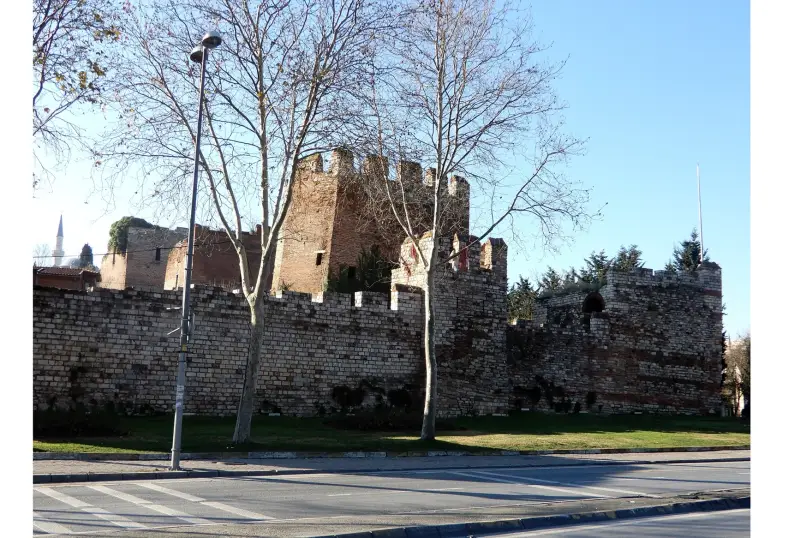
Ruins of the fortifications of Blachernae from the Golden Horn. Istanbul. Türkiye. Photo by the author.
It is very strange that this palace was located in a dangerous direction. I wrote earlier that the overwhelming number of attackers did this in the Vlaherna area.
Meanwhile, the crusaders captured the Roman Fr. Euboea and began to land in the city of Abydos (modern Canakkale) on June 1, 1203:
To be continued ...
Information